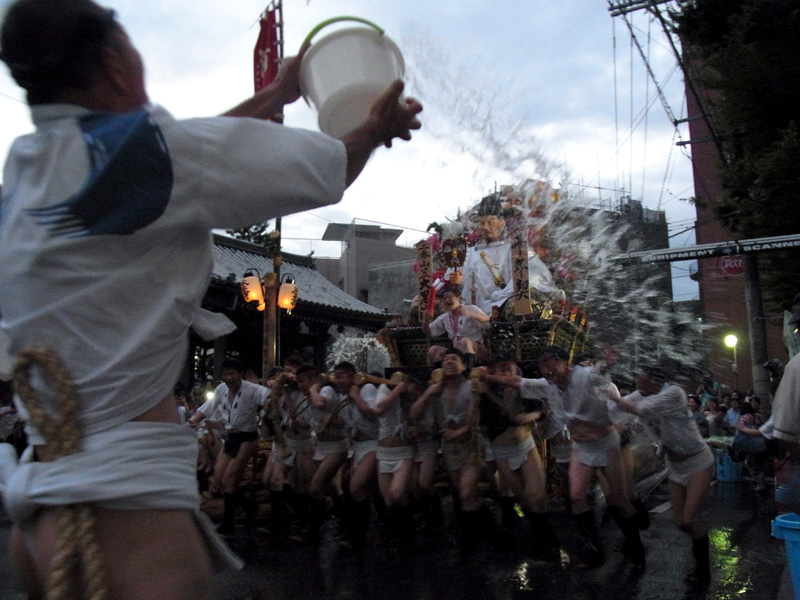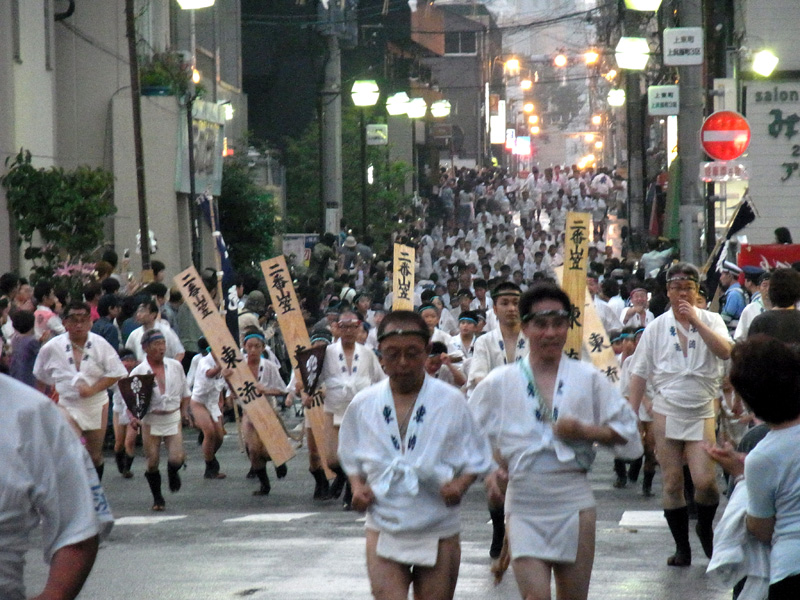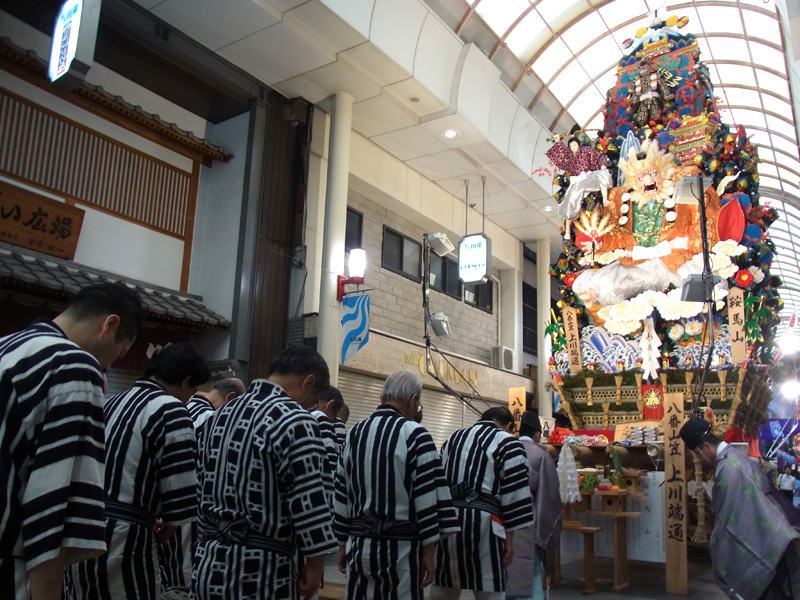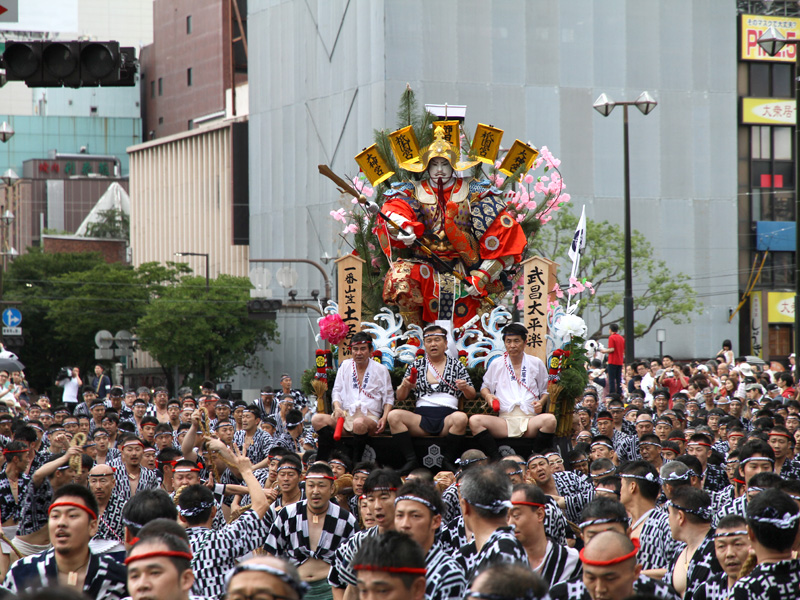

Yamakasa Schedule
An overview of the main events
The Oiyama (15th of July)

The finale and the climax of the 15 days of the Hakata-Gion-Yamakasa festival!
The begin of the final event of the festival is at 4:59 in the morning. The first Kakiyama begins with the presentation before the Kushida shrine. A total of seven Kakiyama are presented to the shrine one after another.
For a larger map click [here].
Before the shrine feeling the tension going up



The seven Kakiyama along with Kamikawabata-tooris carryable kazariyama line up at the Reisen-park before they start the race. Even people who have already visited the festival before are exited for the race. Also from the park the street Doi-dori (土井通り) heads straight south to the Kushida-shrine allowing fast access to the shrine, making the Reisen-park (冷泉公園) our recommendation for a watching point.
The selection of the men who will carry the Kakiyama, which is called Bōzeri (棒競り), is also worth seeing. It is usually carried out one hour before race and the men who want to carry the Kakiyama stand in a tight line before a judge and try to push themselves forward while making serious faces. The judge then picks out the carriers by slapping them on the arms. To be picked as a carrier is an honour so a lot of young men will try to get in.
Because of all the men trying to be picked and the heat of the summer in Fukuoka the refreshment vending machines are often crowded or already empty, which is why we would recommend bringing your own drinks with you.

Regrettably, watching the actual presentation of the Kakiyama is only possible with tickets (桟敷券) for the spectators loge. Getting these tickets is extremely hard since they sell out within 15 minutes after becoming available on the 26th of June and sometimes are resold for tens of thousands of yen (hundreds of Dollars/ Pounds).
However, the sounds of the ceremony are relayed by speakers and the atmosphere is enough to enjoy the occasion with the large crowd in front of the Shrine.

There are also a lot of interesting sights around the Kushida-shrine and once the crowd has dispersed after the festivities, visiting the shrine itself and surrounding interesting spots is much easier.
The exitement could not get any more powerful during the Kushida-iri!

If you have the luck to get one of the tickets, you can see the presentation ceremony before the Kushida-shrine, called Kushida-iri, live. There are additional seats for free but the waiting line for those is already full on noon of the 14th, 17 hours before the event.
The gates open at 2am, letting the spectators in. Going forward the time till the start of the Oiyama is announced in regular intervals.

Just before the start the drumming and the shouting of the participating men make it almost impossible to sit quietly in your seat. The arrival of the Kakiyama is heralded by the carriers shouting “Oisa”, the battle cry of the festival. To the spectators chanting the Hakata Iwaimedeta the Kakiyama is carried around the center flag and loops back to where it came from.
After the first Kakiyama has left, every five minutes another Kakiyama arrives. For the other ones the spectators clapp but the Hakata Iwaimedeta is only sung for the first Kakiyama.



At the end, when all seven districts Kakiyama have made their way through the presentation road, it is Kamikawabata-tooris turn. Kamikawabata-toori makes a large Kazariyama every year and runs it through certain parts of Hakata with the other Kakiyama. This Running-Kazariyama is decorated just as richly as the other stationary ones but is carried as they were originally supposed to be carried through the city, which is only possible in certain places since the electronic power lines are in the way.
Running through Hakata at dawn!



At 4:59 in the morning then the Oiyama begins it is still dark. However while the Kakiyama make their way through Hakata, the sun comes up, and is greetet with the perpetual shouts of “Oisa” coming from the carriers.



After a long trip up and down the length of Hakata the Kakiyama come out of the courses small side alley, which is the hardest part of the run, and find themselves on the wide Meji-dori for the last part of the race. Here they give their last, fighting for every second, that they can get over the other districts teams. The shouts of “Oisa” rise up again one last time before finally reaching the finish line.

The time of each team is announced shortly after their arrival from the second floor of a local sweets shop. The time is usually met with more applause by the spectators and the other teams.
The happy finale to the festival! The Yamakuzushi (山崩し) that is more than just the close of the festivities.

The Kakiyama are brought back to their districts soon after the race and following a gathering of the district is immediately demolished. Destroying the Kakiyama gives a clear cut end to the festivities and instills a sense of accomplishment and peace of mind in the inhabitants of Hakata. The change in attitude is noticeable, so keep your eyes open for it.
When demolishing the old Kakiyama, fist the outer decorations and puppets are stripped and placed upon the districts own decoration stand. The carriers take the stand and shake it while everyone sings.

After that, the carrying poles are brought away to be stored until next year.
For the next five days or so the memory of the shouting carriers carrying the Kakiyama lingers in the city and small children wishing back the time of the festival can be seen.
After 15 days of weird sights such as a group of men carrying a handbarrow through the city in early morning, the city reverts to its every day life.
The festival is said to mark the end of the rainy season in Fukuoka before the hot summer arrives.














